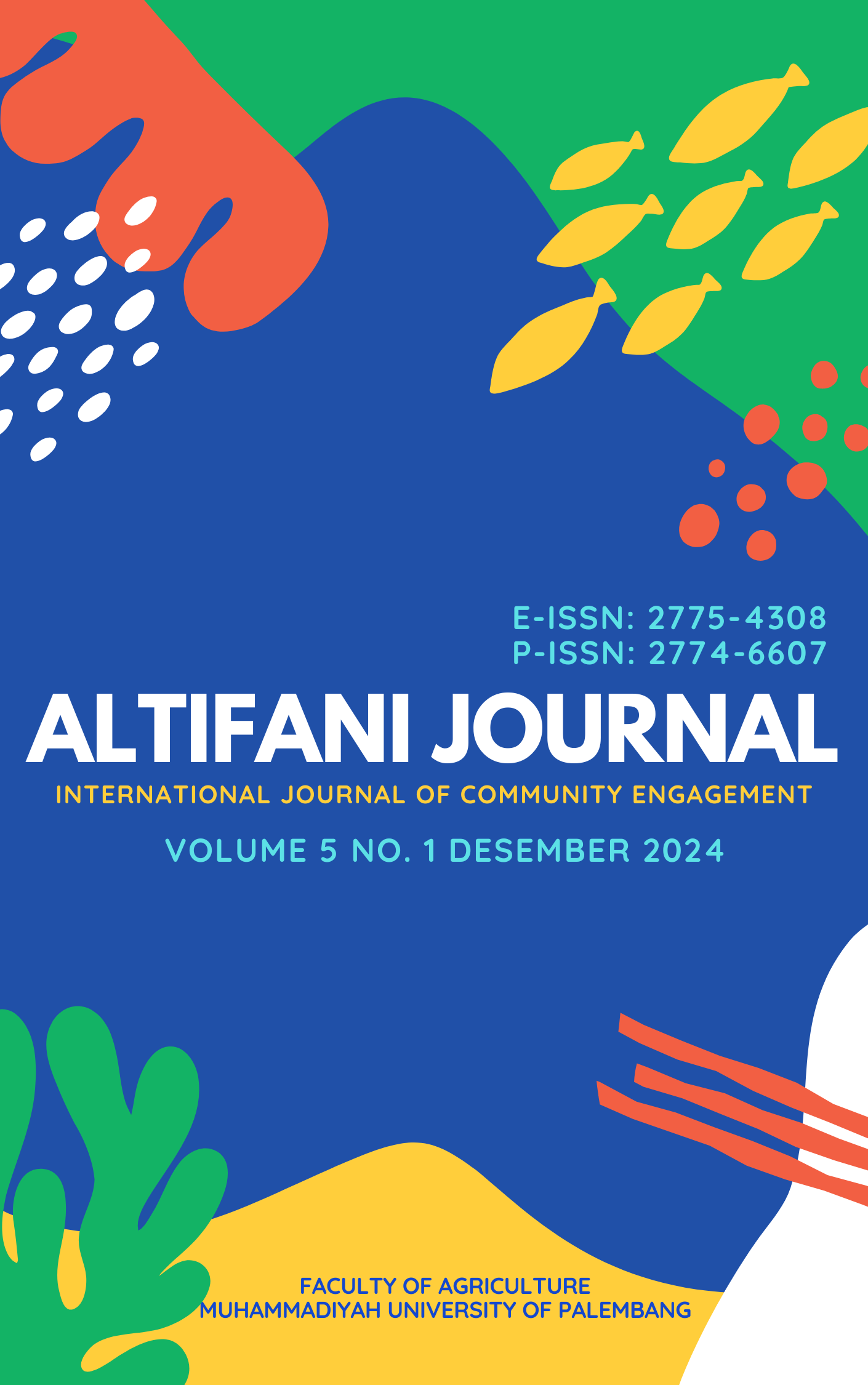Application of Waste Trap Design for Mangrove Ecosystem based on Community Empowerment
DOI:
https://doi.org/10.32502/altifani.v5i1.286Keywords:
waste manajement, waste trap, mangrove ecosystem, GambesiAbstract
The impact of suboptimal waste management caused some people in Gambesi Village, Ternate City choosing to throw their waste into the river. It is eventually carried to the coastal area. Application waste trap technology at the river downstream can prevent waste from being carried to the sea. Therefore, the community service activity team try to apply waste traps in the Gambesi downstream river which is connected to mangrove ecosystem. This activity is carried out in several stages: socialization regarding actual environmental conditions, application of waste trap technology, and mentoring of partner groups. The outputs obtained in this activity are increasing understanding and skills in waste management, installing waste traps in the mangrove ecosystem, and building collaboration with waste management units in Ternate City. The implementation of the socialization has been carried out and attended by 45 participants who are members of Karang Taruna, citizen of Gambesi, and students. The socialization material includes an explanation of waste problems in Ternate City, the impact of waste on health and the environment, the function of waste traps, and methods of application. Participants of the socialization revealed that they were aware of the waste problem in their environment, but only recently learned that waste traps could be one solution to the problem. The installation of waste traps in Gambesi Village was carried out to estuary connected to the sea and the mangrove ecosystem. At that location, 10 traps were installed. Then, the trapped waste wassorted according to its type.
References
Badan Pusat Statistik Kota Ternate. (2024). Kota Ternate dalam Angka. Ternate: BPS Kota Ternate.
Bahtiar, Ahmad, Z., Pobi, W. (2017). Sampah Rumah Tangga di Ternate. Techno Jurnal Penelitian, 6(02), 57-65.
Basyuni, M., Sasmito, S. D., Analuddin, K., Ulqodry, T. Z., Saragi-Sasmito, M. F., Eddy, S., & Milantara, N. (2022). Mangrove biodiversity, conservation and roles for livelihoods in Indonesia. In Mangroves: Biodiversity, livelihoods and conservation (pp. 397-445). Singapore: Springer Nature Singapore.
Hay, J.E., Forbes, D.L., & Mimura, N. (2013). Understanding and managing global change in small islands. Sustainability Science, 8, 303-308.
Kurniawan, A., Nurdin, A. S., Baguna, F. L., Utami, N. N., & Gunawan, G. (2022). Strategi Penghidupan Masyarakat Sekitar Kawasan Hutan yang Berkelanjutan Di Pulau Tidore Provinsi Maluku Utara. In Prosiding Seminar Nasional Pertanian, Vol. 2, No. 1.
Kusmana C. (2014). Distribution and current status of mangrove forest in Indonesia. Di dalam: Faridah-Hanum I,Latiff A, Hakeem KR, Ozturk M, editor. Mangrove ecosystems of Asia: Status, Challenges and Management Strategies. New York (US): Springer.
Luo, Y. Y., Not, C., & Cannicci, S. (2021). Mangroves as unique but understudied traps for anthropogenic marine debris: a review of present information and the way forward. Environmental Pollution, 271, 116291.
Martin, C., Almahasheer, H., & Duarte, C. M. (2019). Mangrove forests as traps for marine litter. Environmental Pollution, 247, 499-508.
Nurse, L. A., McLean, R. F., Agard, J., Briguglio, L. P., Duvat-Magnan, V., Pelesikoti, N., & Webb, A. (2014). Small islands. Climate change 2014: Impacts, adaptation, and vulnerability. Part B: Regional aspects. Contribution of working group II to the fifth assessment report of the intergovernmental panel on climate change, pp-1613.
Paembonan, R. E., Achmad, M. D., Marus, I., Baddu, S., Karman, A., Najamuddin, N., ... & Ismail, F. (2022). Hutan mangrove di Pulau Ternate secara spasial dan temporal. Jurnal Ilmu Kelautan Kepulauan, 5(2).
Pemerintah Indonesia. (2007). Undang-undang No. 27 Tahun 2007 tentang Pengelolaan Wilayah Pesisir dan Pulau-pulau Kecil. Jakarta: Pemerintah Indonesia
Rivaldy, D. R., Jansen, T., & Sumarauw, J. S. (2018). Evaluasi Kapasitas Penampang Sungai Tugurara Kota Ternate Terhadap Debit Banjir. Jurnal Sipil Statik, 6(6).
Saenger, P. (2013). Mangrove ecology, silviculture and conservation. Springer Science & Business Media.
Sahil, J., Al Muhdar, M. H. I., Rohman, F., & Syamsuri, I. (2016). Sistem pengelolaan dan upaya penanggulangan sampah di Kelurahan Dufa-Dufa Kota Ternate. Jurnal Bioedukasi, 4(2).
Sofyan, A., Sunarto, S., Sudibiyakto, S., & Sahubawa, L. (2010). Kajian Erosi Marin Sebagai Penyebab Degradasi Kepesisiran Kota Ternate (The Study of Marine Erosion as A Coastal Degradation in Ternate City). Jurnal Manusia dan Lingkungan, 17(2), 89-97.
Somadayo, S. (2021). Efektifitas Pengelolaan Sampah di Kota Ternate. Jurnal Sains Sosial dan Humaniora (JSSH), 1(1), 100-103.
Wafar, S., Untawale, A. G., & Wafar, M. (1997). Litter fall and energy flux in a mangrove ecosystem. Estuarine, coastal and shelf science, 44(1), 111-124.
Whidayanti, E., Handayani, T., & Manessa, M. D. M. (2021). A spatial study of mangrove ecosystems for abrasion prevention using remote sensing technology in the coastal area of Pandeglang Regency. In IOP Conference Series: Earth and Environmental Science (Vol. 771, No. 1, p. 012014). IOP Publishing.
Whitfield, A. K. (2017). The role of seagrass meadows, mangrove forests, salt marshes and reed beds as nursery areas and food sources for fishes in estuaries. Reviews in Fish Biology and Fisheries, 27(1), 75-110.
Downloads
Published
Issue
Section
License
Copyright (c) 2024 Altifani Journal: International Journal of Community Engagement

This work is licensed under a Creative Commons Attribution 4.0 International License.


















